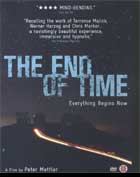
The End of Time 2012
Distributed by First Run Features, 630 Ninth Avenue, Suite 1213, New York, NY 10036; 212-243-0600
Produced by Peter Mettler & Silva Basmajian
Directed by Peter Mettler
DVD , color, 114 min.
College - General Adult
Earth Sciences, Experimental Film, Natural History, Philosophy, Physics, Sociology, Time
Date Entered: 10/09/2014
Reviewed by Steve Bertolino, Reference and Instruction Librarian, Middlebury College, Middlebury, VTIn my opinion, it’s difficult to call this film a documentary. While it does document several things loosely related to the conception, measurement, representation, and passage of time, it does so in a non-linear way, relying mostly on links within its editing to establish continuity and a semblance of a narrative. There is no particular argument the film makes concerning time, save that we know less than we think we do about it and it is something almost wholly experiential. This is not necessarily a poor or false argument, but it’s a curious decision to make it using a primarily visual medium which, apart from frame-rate speed manipulation (which the film certainly uses more than it should), has nothing else naturally in the experience of making or watching a film which would make the medium a strong choice for this argument. In fact, most of the film resembles two other media which would have been much stronger choices: photography and the tone poem.
Mettler lingers over still shots, mostly of nature or of machinery, which recall the styles of Antonioni or Kubrick, and as with those directors, Mettler often gives in to the temptation of the idea that an image is more powerful than a narrative, and sometimes he lets his images trump cohesion. At points, this approach works, notably in the Detroit section of the film, which focuses on decay. However, the dangers of a lack of context or direction often lead to what I must assume are unintentional associations. During the CERN segment, there’s a strong fetishization of the collider and other machines, not at all encouraged by the scientists in their brief interview snippets, who view them as tools used in order to accomplish research, but encouraged by Mettler as his camera repeatedly lingers over the shapes and surfaces and blinking lights, trying to impart meaning to them. But without knowing what they are or do or seeing them “work,” they simply look like particularly realistic movie props, and carry no emotional or argumentative weight. When the film moves into its Hawaii segment, Mettler inexplicably chooses to show slow-motion footage of native Hawaiian women performing a hula dance. Again, without context, the effect of this is to exoticize these people and their performance, making it empty except for a strong sense that this is somehow “other” to the viewer’s experience. (A few lines of overly precious voice-over immediately preceding the shot which talk about how two people standing a distance apart from each other see a rainbow in the sky two different ways doesn’t help.) This is the downside to a tone poem: images which form no particular cohesion or connection, leaving an audience wondering exactly what in the world is going on. In the Bodh Gaya section of the film, such shots of people worshipping at the temple are put into context by his interview subjects, Buddhists in varying degrees of faithfulness, and the visual rites and rituals are mentioned by them. But the earlier scene still jars.
I can see some limited usefulness in this film in a classroom setting, for film students learning how to edit and wanting a mixed bag of strong and weak editing choices on display. Likewise if a discussion of time and perception is happening in a philosophy class, this film would be an interesting conversation piece, though the voice-overs do include some execrable faux-philosophical lines, such as “Time’s not a thing. It’s an idea. It’ll die out in the mind.” In the end, this seems to me to be one of those “documentaries for documentarians,” where half the time you’re wondering exactly how the camera captured that particular shot, rather than experiencing an immersion into the content. And it really is a beautiful string of images; the lava streams in Hawaii and, later, the Detroit houses literally falling apart, are truly gorgeous. In the last twenty minutes, the film is essentially a series of images from all the places the filmmakers visited, in another attempt to collage them into meaning. While the scope and colors and shapes are impressive, there’s just no sense that it all adds up to something.